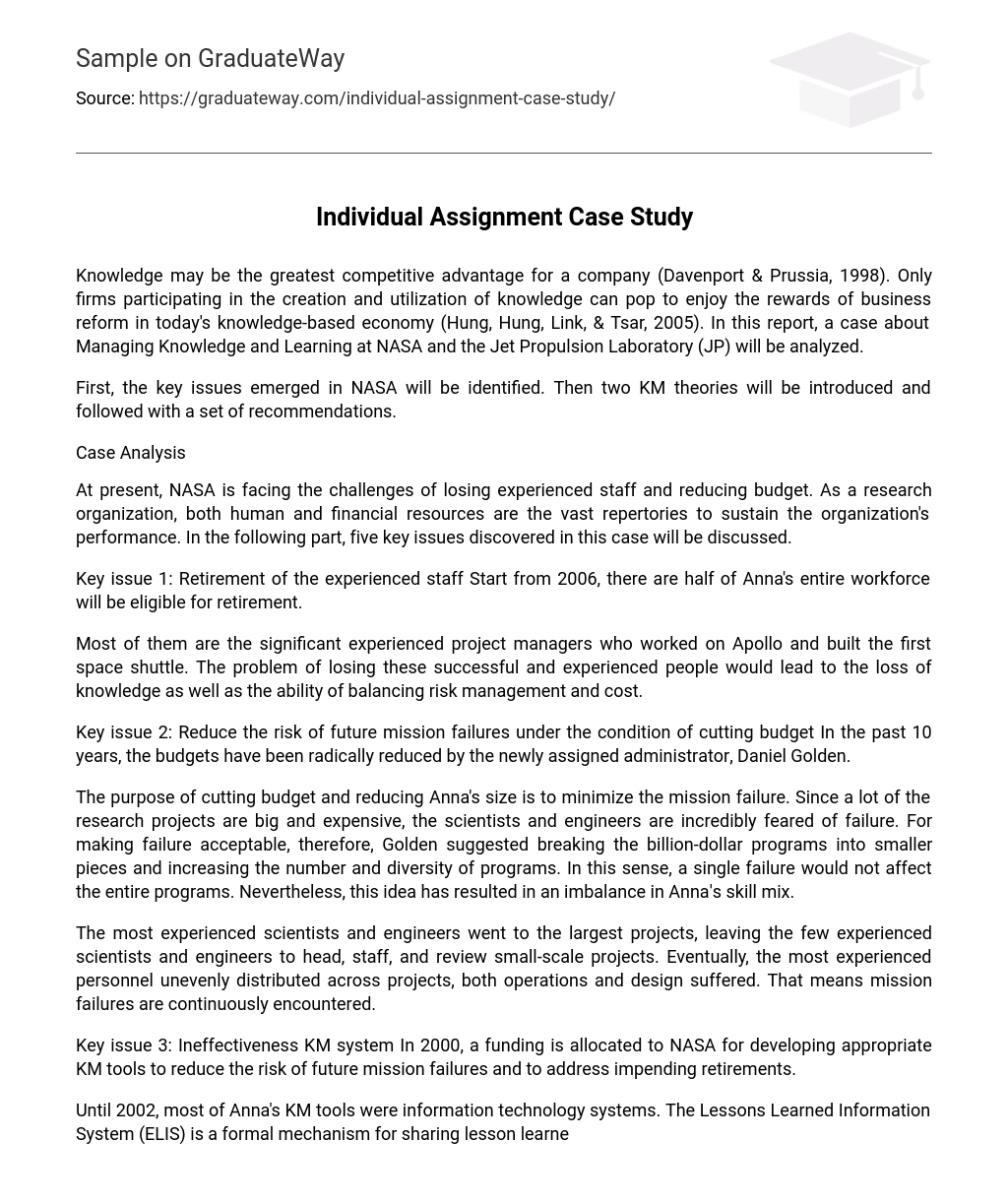Knowledge may be the greatest competitive advantage for a company (Davenport & Prussia, 1998). Only firms participating in the creation and utilization of knowledge can pop to enjoy the rewards of business reform in today’s knowledge-based economy (Hung, Hung, Link, & Tsar, 2005). In this report, a case about Managing Knowledge and Learning at NASA and the Jet Propulsion Laboratory (JP) will be analyzed.
First, the key issues emerged in NASA will be identified. Then two KM theories will be introduced and followed with a set of recommendations.
Case Analysis
At present, NASA is facing the challenges of losing experienced staff and reducing budget. As a research organization, both human and financial resources are the vast repertories to sustain the organization’s performance. In the following part, five key issues discovered in this case will be discussed.
Key issue 1: Retirement of the experienced staff Start from 2006, there are half of Anna’s entire workforce will be eligible for retirement.
Most of them are the significant experienced project managers who worked on Apollo and built the first space shuttle. The problem of losing these successful and experienced people would lead to the loss of knowledge as well as the ability of balancing risk management and cost.
Key issue 2: Reduce the risk of future mission failures under the condition of cutting budget In the past 10 years, the budgets have been radically reduced by the newly assigned administrator, Daniel Golden.
The purpose of cutting budget and reducing Anna’s size is to minimize the mission failure. Since a lot of the research projects are big and expensive, the scientists and engineers are incredibly feared of failure. For making failure acceptable, therefore, Golden suggested breaking the billion-dollar programs into smaller pieces and increasing the number and diversity of programs. In this sense, a single failure would not affect the entire programs. Nevertheless, this idea has resulted in an imbalance in Anna’s skill mix.
The most experienced scientists and engineers went to the largest projects, leaving the few experienced scientists and engineers to head, staff, and review small-scale projects. Eventually, the most experienced personnel unevenly distributed across projects, both operations and design suffered. That means mission failures are continuously encountered.
Key issue 3: Ineffectiveness KM system In 2000, a funding is allocated to NASA for developing appropriate KM tools to reduce the risk of future mission failures and to address impending retirements.
Until 2002, most of Anna’s KM tools were information technology systems. The Lessons Learned Information System (ELIS) is a formal mechanism for sharing lesson learned across the agency. It contains lessons from the operation or design of particular missions and project elements. However, case study 26 May 2007 Lee Holcomb, the Chief Information Officer in NASA realized IT systems alone could not fully address Anna’s mandate. It is because IT systems do not address the critical need for the most experienced people to mentor and train others or to share tacit knowledge from one mission to another.
Besides, an U. S. Government reported that the L’S covers too many topics. Hence, it is difficult to search for an applicable lesson and hard to weed through the irrelevant lessons. Anna’s project managers were reluctant to share negative lessons for fear that they might not be viewed as good project managers. Moreover, the competitions among the organization also cultivate a culture of propagating knowledge. It is obvious that the knowledge- sharing culture in NASA is weak while knowledge-sharing is majority in KM application.
Key issue 5: Reliability on IT systems or others KM tools At present, the use of IT systems is the only way to capture and distribute knowledge in NASA The KM team is facing the dilemma that do they continue on the IT track or introduce the other possibility like promoting the knowledge-sharing culture across the organization. Although the second option would bring a lot of advantages to NASA, it requires more funding. That seems impossible due to the budget deduction. Also if this method is unsuccessful, the credibility of KM team will lose.
Case study 26 May 2007 3 Application of KM theories In this section, two KM theories based on Knowledge Management In Theory and Practice (Dallier, 2005) will be introduced.
Monika-Attacked Model of Knowledge Management
The core of the Monika-Attacked Model is making personal knowledge available to others in the company. This model emphasis on the transformation process regard to tacit and explicit knowledge. It takes place continuously and applicable at all levels of the organization such as individual, groups and company-wide.
Monika-Attacked Model There are four types of knowledge transformation processes in this model. In the following, an explanation for each process will be discussed. 1. Tacit to Tacit transformation – Colonization Tacit knowledge is difficult to articulate. Hence, the transformation of tacit to tacit knowledge is mainly relying on learning from the master. Thought the colonization activities such as mentoring, coaching and observation etc, individual can learn certain extent knowledge from ease study May 2007 the others.
However, the knowledge remains tacit and is not leveraged across the Tacit to Explicit transformation – Sterilization By recording the tacit knowledge in print or non-print format, knowledge will become explicit and able to articulate. Usually, the process of tacit to explicit knowledge requires the assistance of intermediary, for example, a journalist or a workshop. After the transformation process, knowledge is existed in tangible format. Hence, it is easy to share with others and leverage throughout the organizations.





